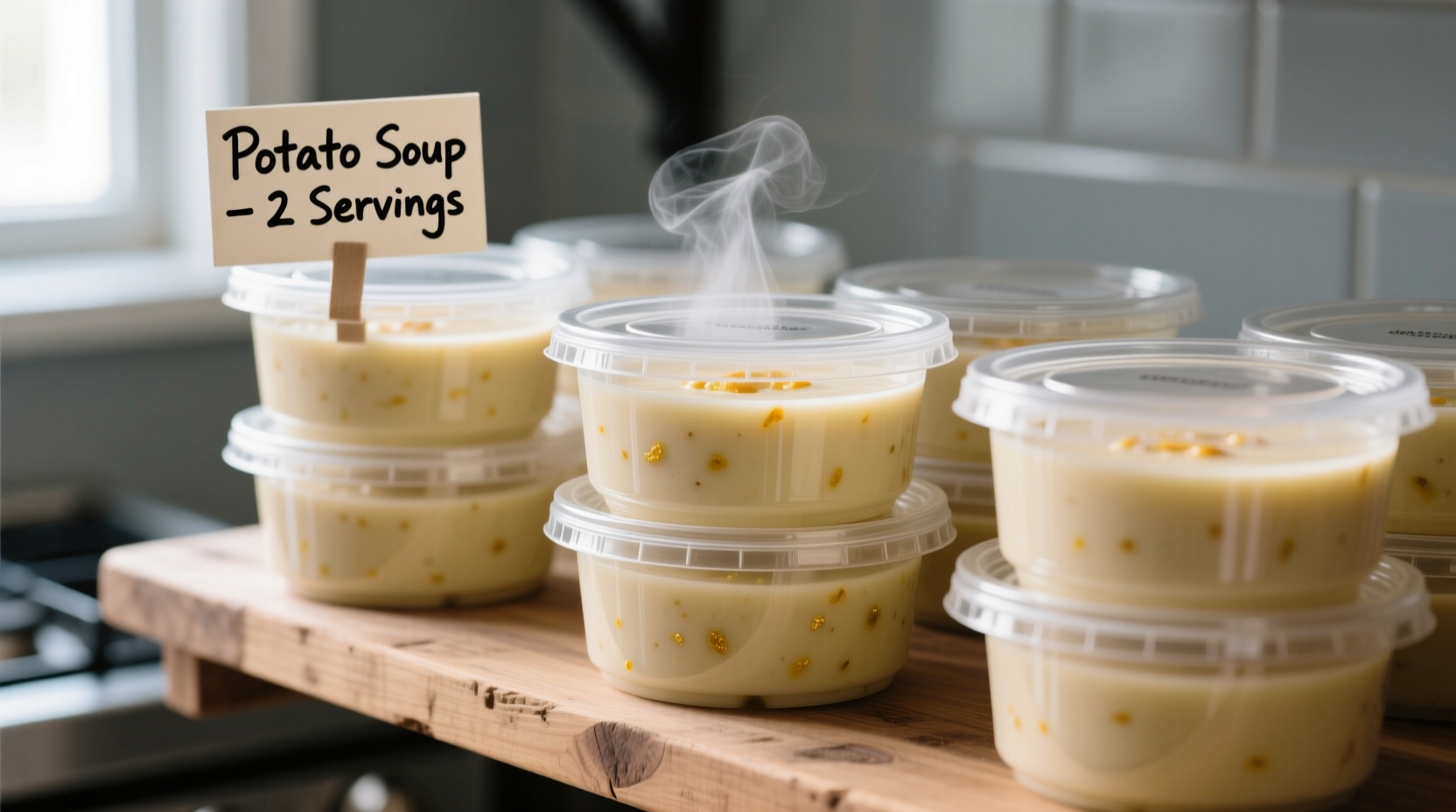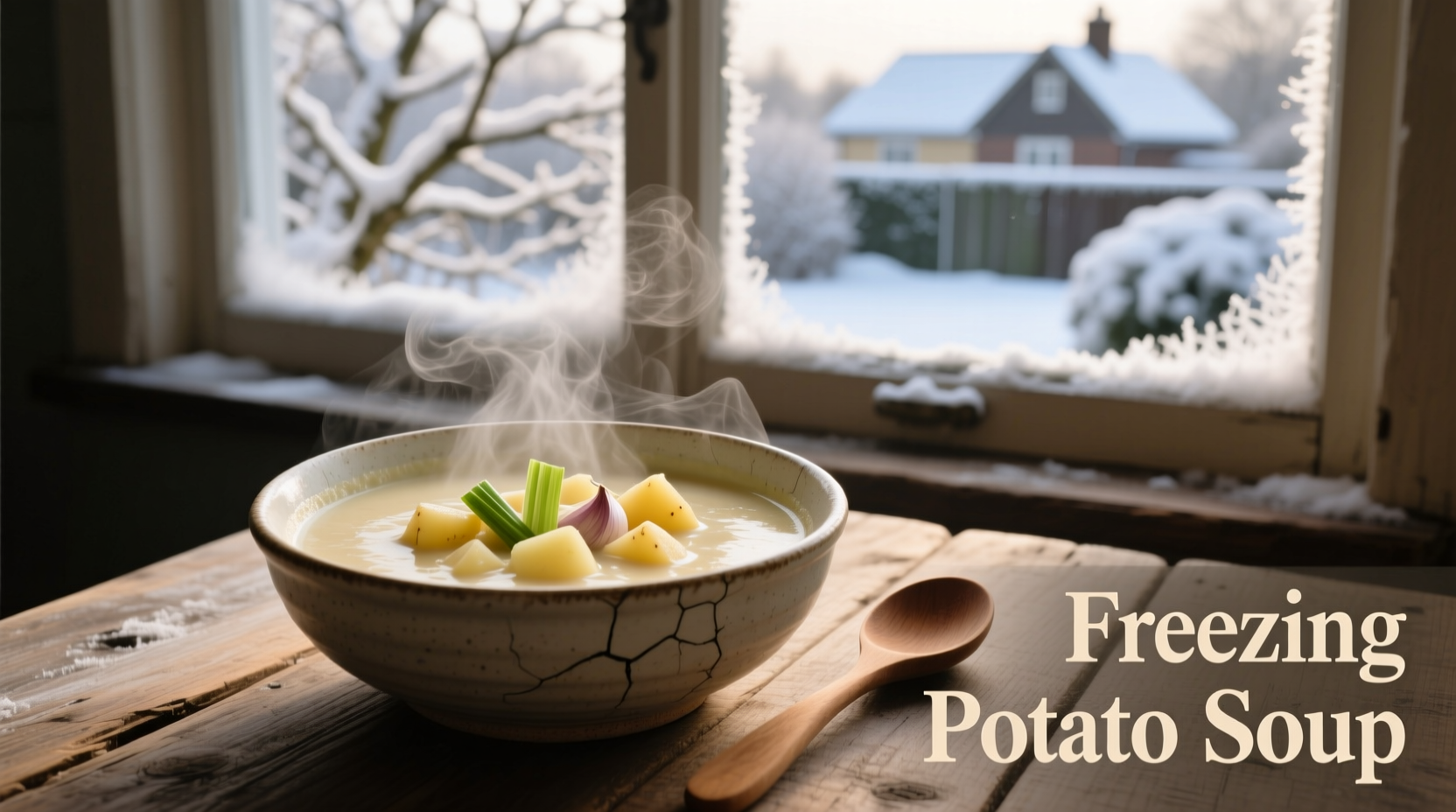Yes, you can safely freeze potato soup for up to 6 months when stored properly in airtight containers with 1-inch headspace for expansion. Dairy-based versions require special handling to prevent separation, and proper cooling before freezing is critical for food safety.
The Complete Guide to Freezing Potato Soup Without Losing Texture
As a French-trained chef who's perfected hundreds of soup recipes across European kitchens, I've seen how improper freezing ruins even the most carefully crafted potato soup. The good news? With the right technique, your frozen potato soup can taste nearly as fresh as the day you made it. Let's solve your freezing challenges step by step.
Why Potato Soup Presents Unique Freezing Challenges
Potato soup's starch content creates specific freezing hurdles that don't affect broth-based soups. When potatoes freeze, their cell structure changes, potentially leading to grainy texture or separation upon thawing. Dairy components like cream or cheese introduce additional complications as fats can separate during temperature changes.
According to the USDA Food Safety and Inspection Service, proper cooling before freezing is critical to prevent bacterial growth. Their guidelines state that hot food should cool to 70°F within 2 hours and reach 40°F within 4 hours total before refrigeration or freezing (USDA Cooling Guidelines).
| Soup Type | Freezer Stability | Max Storage Time | Special Considerations |
|---|---|---|---|
| Potato soup (dairy-free) | High | 6 months | Best texture retention when cooled properly |
| Cream-based potato soup | Moderate | 3 months | Add dairy after reheating for best results |
| Potato soup with cheese | Low | 2 months | Cheese often becomes grainy; consider adding fresh |
Step-by-Step Freezing Process for Perfect Results
Follow this professional kitchen-tested timeline to freeze your potato soup correctly:
- Cool Completely (2-4 hours): Never freeze hot soup. Spread in shallow containers to cool faster while maintaining food safety. Stir occasionally to release heat evenly.
- Portion Strategically: Divide into single-serving portions using freezer-safe containers with tight lids. Leave 1-inch headspace for expansion as liquids expand when frozen.
- Label Thoroughly: Include date and contents. For cream-based versions, note "add dairy after reheating" as a reminder.
- Flash Freeze (Optional but Recommended): Place containers uncovered in freezer for 1-2 hours until surface solidifies, then cover completely. This prevents ice crystals from forming on the soup surface.
- Store Properly: Place containers toward the back of the freezer where temperature is most consistent. Avoid freezer door storage where temperature fluctuates.

When Freezing Potato Soup Won't Work
Not all potato soups freeze well. Understanding these context boundaries prevents disappointing results:
- Dairy-heavy recipes: Soups with more than 1 cup cream per quart often separate irreparably. Solution: Freeze base without dairy and add cream when reheating.
- Overcooked potatoes: Potatoes that were already soft before freezing turn to mush. Solution: Slightly undercook potatoes (about 75% done) before freezing.
- Long-stored soup: Soup that's been refrigerated for more than 3 days before freezing has reduced quality. Solution: Freeze within 24 hours of preparation.
- High-acid additions: Soups with tomatoes or wine added after cooking may develop off-flavors. Solution: Add acidic components when reheating.
Thawing and Reheating for Restaurant-Quality Results
How you thaw and reheat makes or breaks your frozen potato soup. Follow these professional methods:
Safe Thawing Methods
- Refrigerator Method (Best): Transfer container to refrigerator 24-48 hours before needed. Keeps soup at safe temperature throughout thawing.
- Cold Water Method (Faster): Submerge sealed container in cold water, changing water every 30 minutes. Takes 2-3 hours for quart-sized portions.
- Never thaw at room temperature - this creates dangerous temperature zones where bacteria multiply rapidly.
Reheating Techniques That Restore Texture
- Stovetop Method: Gently warm over medium-low heat, stirring frequently. For cream-based soups, whisk in 1-2 tablespoons of cream or milk while reheating to restore smoothness.
- Fixing Separation: If dairy separates, remove from heat and whisk in 1 teaspoon cornstarch slurry (1:1 cornstarch:water) until smooth.
- Reviving Texture: Add a small potato (½ cup diced) while reheating to absorb excess moisture and improve texture.
Freezer Storage Timeline and Quality Expectations
Understanding how potato soup quality changes over time helps you use frozen portions at their peak:
- 0-3 months: Near-fresh quality, minimal texture changes. Ideal for cream-based soups.
- 3-6 months: Slight texture changes in potatoes, but still excellent quality for dairy-free versions.
- 6-9 months: Noticeable texture degradation, potential freezer burn. Use only if properly packaged.
- 9+ months: Significant quality loss. Discard for best results.
The National Center for Home Food Preservation confirms that properly frozen soups maintain best quality for 2-3 months, though remain safe indefinitely when kept at 0°F (NCHFP Freezing Guidelines).
Troubleshooting Common Freezing Problems
Even with careful preparation, issues sometimes arise. Here's how to fix them:
- Grainy texture: Blend soup with immersion blender after reheating. The friction creates heat that helps re-emulsify.
- Excess liquid after thawing: Simmer uncovered for 5-10 minutes to reduce. Alternatively, make a small roux to thicken.
- Flavor loss: Brighten with fresh herbs, a squeeze of lemon, or dash of hot sauce when reheating.
- Freezer burn: Skim affected portions before reheating. Prevent future burn by removing air from containers using vacuum sealing.
Maximizing Freezer Space While Preserving Quality
Professional kitchens use these space-saving techniques without sacrificing quality:
- Freezer bags: Lay flat for space-efficient stacking. Squeeze out all air before sealing.
- Ice cube trays: Freeze small portions, then transfer to bags. Perfect for adding to other dishes.
- Vacuum sealing: Removes air that causes freezer burn, extending quality period by 2-3 months.











 浙公网安备
33010002000092号
浙公网安备
33010002000092号 浙B2-20120091-4
浙B2-20120091-4